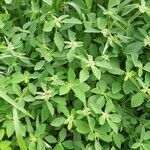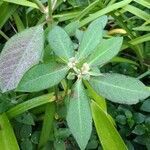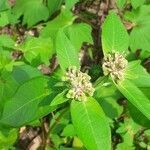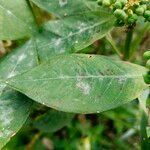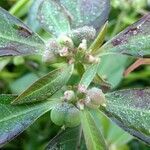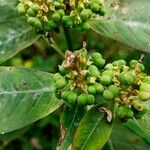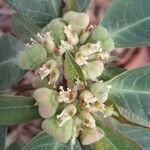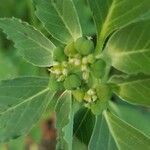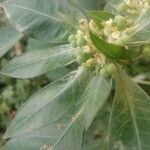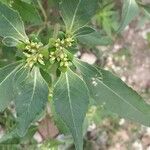Erect annual herb to 1 m. high, with branches glabrous to sparsely pilose towards the apices, often tinged red.. Leaves ovate, to 12 × 6 cm., base cuneate, apex obtuse, margin with minute distant gland-tipped teeth, occasionally more coarsely toothed, upper surface glabrous to sparsely pilose around the edges, lower surface pilose with septate hairs especially on the midrib and nerves, glabrescent; petiole to 2(–4) cm. long; glandular stipules fairly large, purplish.. Cyathia densely clustered in axillary and terminal cymes forking ± 5 times, with progressively shorter rays from ± 15 cm. to ± 2 mm. long; basal bracts similar to the leaves but paler green, progressively smaller, more lanceolate and subsessile above.. Cyathia glabrous, ± 3.5 × 2.5 mm., with goblet-shaped involucres; gland peltate, funnel-shaped, 1 mm. long, the opening circular, 1.2 mm. across, red-rimmed; lobes subcircular, ± 1.3 mm. long, deeply and sharply toothed with margins minutely ciliate.. Male flowers: bracteoles few, ligulate, feathery; stamens 4 mm. long.. Female flower: ovary pedicellate, glabrous or occasionally with minute scattered hairs, the perianth forming an obvious rim; styles ± 1 mm. long, occasionally minutely puberulous, bifid to halfway.. Capsule exserted on a reflexed pedicel to 6 mm. long, deeply 3-lobed, ± 4.5 × 5.5 mm.. Seeds conical with acute apex, 2.6 × 2.4 mm., blackish brown, surface bluntly tuberculate.
Herbs, annual, erect to 1 m tall, often tinged red. Stem glabrous to sparsely pilose at apex, hollow. Leaves alternate; stipules purplish glands, fairly conspicuous; petiole to 2(-4) cm; leaf blade ovate, to 12 × 6 cm, abaxially pilose especially on midrib and veins, glabrescent, adaxially glabrous to sparsely pilose near margin, base cuneate, margin with minute distant gland-tipped teeth, apex obtuse. Cymes terminal and axillary, each forking ca. 5 times, cyathia densely clustered; basal bracts similar to leaves but paler green, progressively smaller. Cyathia ca. 3.5 × 2.5 mm; involucre barrel-shaped, glabrous; gland ca. 1 mm, funnel-shaped, opening circular, ca. 1.2 mm across, often red-rimmed; lobes ca. 1.3 mm, subcircular, deeply toothed with minutely ciliate margins. Male flowers: bracteoles few, ligulate, feathery; stamens ca. 4 mm. Female flower: ovary pedicellate, glabrous or occasionally minutely puberulent, perianth forming an obvious rim; styles ca. 1 mm, occasionally minutely puberulent, bifid to halfway. Fruiting pedicel reflexed to 6 mm; capsule exserted, ca. 4.5 × 5.5 mm, deeply 3-lobed. Seeds conical, ca. 2.6 × 2.4 mm, apex acute, bluntly warty, blackish brown.
Leaves with a petiole to 2(4) cm long; stipules modified as fairly conspicuous purplish glands; lamina to 12 × 6 cm, ovate, obtuse at the apex, cuneate at the base, with minute distant gland-tipped teeth at the margin, occasionally more coarsely toothed, glabrous to sparsely pilose around the edges on the upper surface, pilose with septate hairs especially on the midrib and nerves on the lower surface, glabrescent.
A woody herb. It grows up to 2 m high. The young shoots are hairy with long purple hairs. The stems are green. The leaf stalks have a reddish tinge. The leaf is dark green on the upper surface and dull green underneath. The flowers are cream of light green. They occur closely together at the ends of branches. The fruit are green. The seeds are grey. They are almost round and are rough.
In most specimens from our area the upper leaves and bracts are either entirely green, or with whitish blotches at the base, or tinged purplish on the petiole, nerves and margins; Deighton 4505 and Meikle 877 are specimens of the form with red or orange blotches which is sometimes cultivated.
Annual herb, up to 1 m high. Stems erect. Leaves clustered at ends of stems; blade linear to ovate or obovate, margin toothed; upper leaves and bracts green or often purple-spotted, never red. Flowers: bracts usually ovate, uniformly green; green; Nov.-Apr.
Cyathia c. 3.5 × 2.5 mm with barrel-shaped involucres, glabrous; gland peltate, 1 mm long, funnel-shaped, the opening circular, 1.2 mm across, often red-rimmed; lobes c. 1.3 mm long, subcircular, deeply and sharply toothed with margins minutely ciliate.
Annual herb, up to 1 m high. Leaves linear to ovate or obovate, margin toothed, upper leaves and bracts green or often purple-spotted, never red. Floral bracts usually ovate, uniformly green. Flowers green.
Female flower: ovary pedicellate, glabrous or occasionally with minute scattered hairs, the perianth forming an obvious rim; styles c. 1 mm long, occasionally minutely puberulous, bifid to halfway.
Cymes terminal and axillary, each forking c. 5 times, with rays progressively shorter from c. 15 cm to c. 2 mm long and cyathia densely clustered.
Annual herb erect to 1 m high, often tinged red; stem hollow; branches sparse, glabrous to sparsely pilose towards the apices.
Basal bracts similar to the leaves but paler green, progressively smaller, more lanceolate and sessile above.
Capsule exserted on a reflexed pedicel to 6 mm long, c. 4.5 × 5.5 mm, deeply 3-lobed.
Seeds 2.6 × 2.4 mm, conical with acute apex, bluntly verrucose, blackish-brown.
Male flowers: bracteoles few, ligulate, feathery; stamens 4 mm long.
A rather lax erect annual weed, to 3 ft. high; locally abundant.
